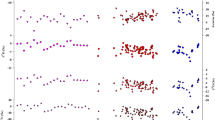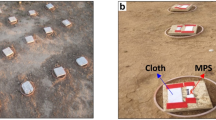Abstract
WHEN I was studying the subject of dew-ponds, I made many hundreds of experiments on dew, and these went to show that under suitable conditions there may be upward dew or downward dew. In his “Essay on Dew”, 1814, republished in 1866, Wells stated that dew was formed from moisture already existing in the air and was deposited on the tops of good radiators. Blythe, however, said in 1836, in his edition of “Selborne”, that “the true theory of dew is that it rises from the ground and does not fall, as is the common opinion”.
This is a preview of subscription content, access via your institution
Access options
Subscribe to this journal
Receive 51 print issues and online access
$199.00 per year
only $3.90 per issue
Buy this article
- Purchase on SpringerLink
- Instant access to full article PDF
Prices may be subject to local taxes which are calculated during checkout
Similar content being viewed by others
Author information
Authors and Affiliations
Rights and permissions
About this article
Cite this article
MARTIN, E. Dew: Does it Rise or Fall?. Nature 124, 513 (1929). https://doi.org/10.1038/124513a0
Issue date:
DOI: https://doi.org/10.1038/124513a0



